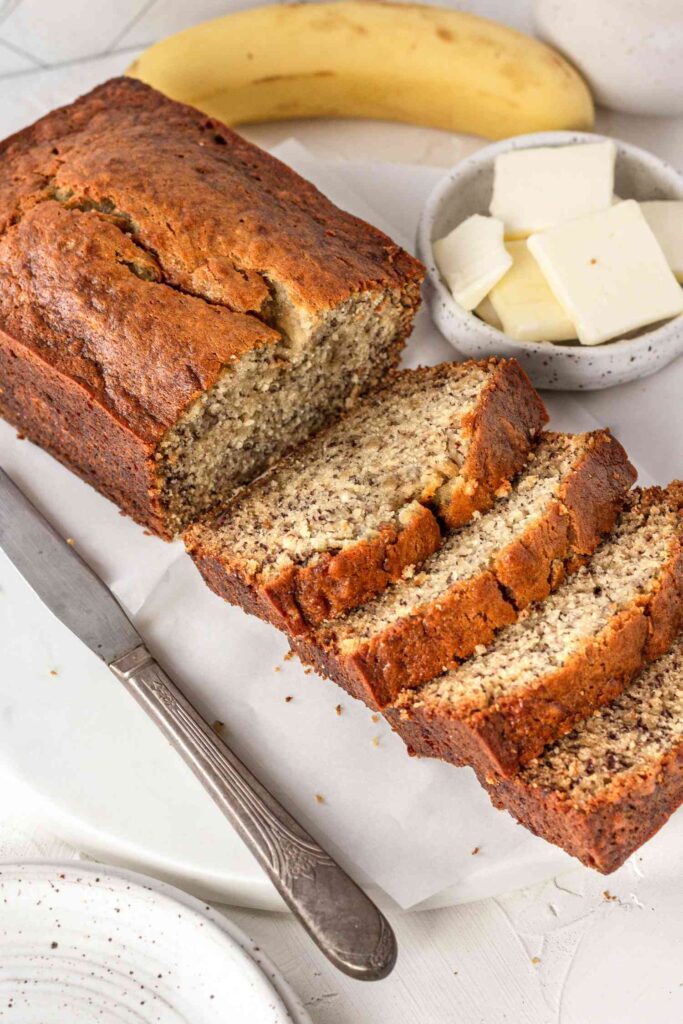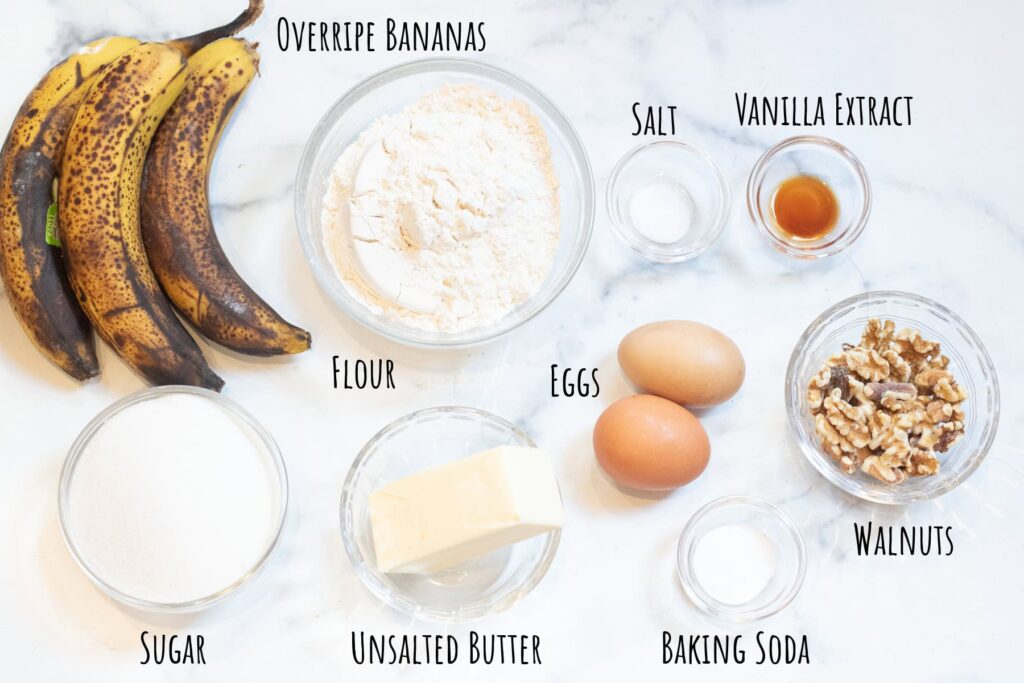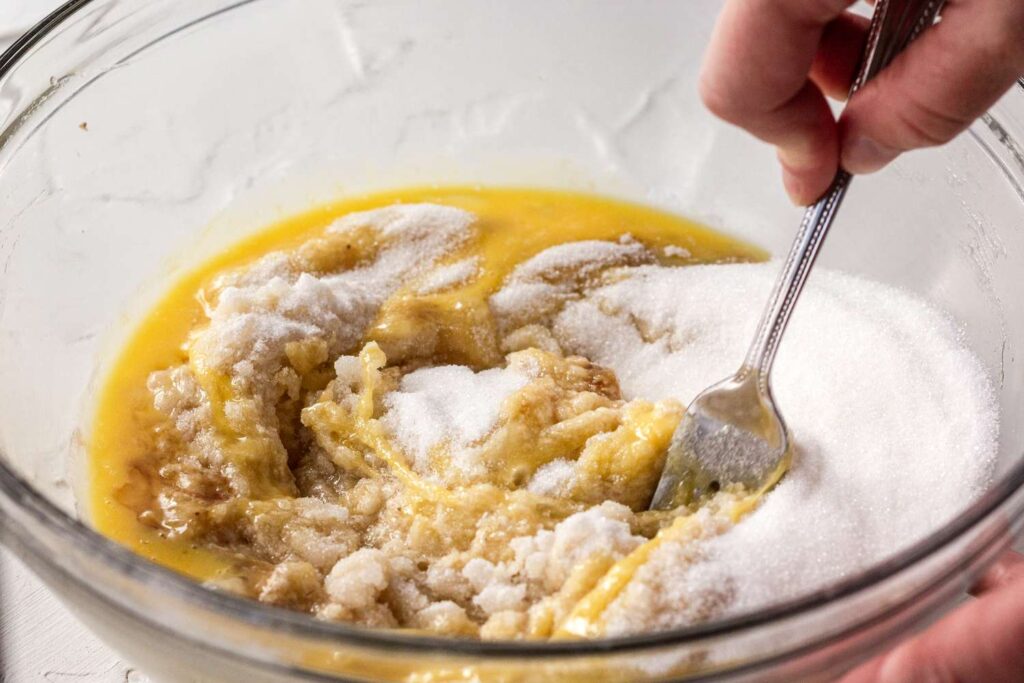Welcome to TASTETROVE Imagine the aroma of ripe bananas mingling with the earthy crunch of toasted walnuts, wafting through your kitchen as a golden loaf emerges from the oven. This isn’t just any quick bread—it’s the Banana & Walnut Loaf, a humble yet indulgent treat that bridges comfort food and culinary artistry. Whether you’re a seasoned baker or a novice with a bunch of overripe bananas begging for redemption, this loaf promises moist tenderness, subtle sweetness, and a satisfying texture that keeps you coming back for slice after slice.
In today’s fast-paced world, where baking has surged in popularity as a mindful escape—think lockdown loaves during the pandemic—this recipe stands out for its simplicity and versatility. It’s not overly fussy, requiring no special equipment beyond a mixing bowl and loaf pan, yet it yields results worthy of a café display. The bananas provide natural moisture and a caramel-like depth, while walnuts add a buttery, nutrient-packed crunch that elevates the loaf from everyday snack to brunch star.
But what makes the Banana & Walnut Loaf truly irresistible? It’s the story behind it—a tale of resourcefulness born from economic hardship, evolving into a global favorite. As we’ll explore, this bake has roots in the Great Depression, when thrifty home cooks turned waste into wonder. Today, it’s a canvas for creativity, from gluten-free twists to chocolate-studded indulgences.
For fellow baking enthusiasts, check out our internal collection of fruit-based loaves for more inspiration. And if you’re curious about the science of baking soda in quick breads, dive into this external guide from King Arthur Baking. In this comprehensive article, we’ll unpack the history, ingredients, step-by-step recipe, variations, tips, nutrition, and serving ideas to help you master this loaf. By the end, you’ll be armed with everything needed to bake your perfect version—perhaps even starting a family tradition.

A Slice of History: From Overripe Bananas to Global Icon
The Banana & Walnut Loaf isn’t just a recipe; it’s a chapter in American culinary history, emblematic of ingenuity during tough times. Banana bread, as it’s commonly known, traces its origins to the early 20th century in the United States, when commercial baking powder became widely available. Before this innovation, breads relied on yeast for leavening, a process that demanded time and patience. Baking powder changed everything, enabling “quick breads” that rose swiftly and used simple pantry staples.
The loaf’s popularity exploded in the 1930s amid the Great Depression. With food scarcity rampant, families sought ways to stretch limited resources. Overripe bananas, often discarded due to their bruised skins, were a cheap and abundant fruit. Housewives, inspired by marketing campaigns from baking companies like Pillsbury, began mashing these “waste” bananas into batters. The first printed recipe for chemically leavened banana bread appeared in 1933 in the Pillsbury Cook Book, marking its official debut in American kitchens. This wasn’t mere thrift; it was alchemy—transforming soft, speckled fruit into a moist, flavorful base that masked imperfections with sweetness.
As King Arthur Baking notes, the Depression-era ethos of “use it up” propelled banana bread into staple status. Walnuts, another affordable add-in, joined the fray for their crunch and nutrition, sourced from California’s burgeoning nut industry. By the mid-20th century, the loaf had evolved beyond survival food. Post-World War II prosperity brought refinements: vanilla extract for aroma, cinnamon for warmth, and even rum-soaked versions for holiday flair.
Globally, adaptations abound. In the Philippines, introduced during American colonial rule, it’s called “banana cake” and often features denser, cake-like textures with coconut. Hawaii’s Road to Hana is famed for its banana bread stands, like Aunt Sandy’s in Keanae, where roadside shacks have baked it since the 1980s using local varieties. In the UK, it’s a tea-time essential, sometimes studded with dates or pecans.
Fast-forward to the 21st century, and banana bread’s resurgence during the COVID-19 lockdowns was no coincidence. Google searches spiked 250% in April 2020, as home bakers channeled anxiety into flour-dusted counters. Social media amplified this, with #BananaBread garnering millions of posts on platforms like Instagram. Yet, its enduring appeal lies in universality: a beginner’s gateway to baking, a vegan-friendly option (with egg substitutes), and a vessel for personalization.
Historians speculate the first walnut iteration emerged in the 1940s, as walnut production boomed in the U.S. West. One theory credits enterprising Oregon farmers promoting their harvest through recipe cards. Whatever the exact origin, the combination endures because it balances banana’s creaminess with walnut’s bite—a yin-yang of flavors.
For a deeper dive into vintage recipes, explore our internal archive of Depression-era bakes. Or, for a visual timeline, check Wikipedia’s entry on banana bread. This loaf isn’t frozen in time; it’s a living tradition, adapting to dietary needs like gluten-free flours or low-sugar sweeteners. As we move to its core components, remember: every loaf tells a story—of scarcity turned abundance, solitude turned solace.
The Star Ingredients: Why Bananas and Walnuts Make Magic
At the heart of every great Banana & Walnut Loaf are two heroes: the humble banana and the robust walnut. These aren’t interchangeable fillers; they’re functional powerhouses that dictate texture, flavor, and even health perks.
Start with bananas. Ripe ones—those with brown spots or fully blackened peels—are non-negotiable. As they overripen, enzymes break down starches into simple sugars, intensifying sweetness and creating a gooey mash that ensures moist crumb. A single medium banana yields about 1/2 cup mashed, packing potassium (422mg per fruit) for heart health and blood pressure regulation. They’re also rich in vitamin B6, aiding serotonin production for mood stability—hence the “happy fruit” moniker. In baking, bananas act as a natural emulsifier, binding fats and liquids without eggs, making them ideal for vegan loafs.
Walnuts elevate this from simple to sophisticated. These tree nuts, native to Persia but thriving in California (producing 99% of U.S. supply), bring omega-3 fatty acids (2.5g per ounce) that combat inflammation and support brain health. Their high antioxidant content—polyphenols rivaling those in dark chocolate—fights oxidative stress. Toasted walnuts release oils for deeper flavor, adding crunch that contrasts banana’s softness. Chop them coarsely (about 1 cup per loaf) to avoid sogginess.
Supporting cast: All-purpose flour provides structure, baking soda (not powder) reacts with banana acidity for lift, and butter or oil ensures tenderness. Sugar tempers banana’s tang, while eggs add richness. For a healthier spin, swap half the flour for whole wheat or almond meal.
Together, these create synergy. Bananas’ pectin thickens the batter, walnuts’ fats prevent dryness, yielding a loaf that’s 70% moister than plain quick bread. Nutritionally, a slice offers fiber (3g) for digestion, magnesium from walnuts for relaxation, and prebiotics from bananas for gut health.
Curious about sourcing? Our internal guide to selecting nuts covers walnut varieties. Externally, learn more on Healthline’s banana bread nutrition breakdown.
This duo isn’t just tasty; it’s therapeutic. Baking them soothes stress, as the rhythmic mashing mirrors kneading dough’s meditative quality. Next, we’ll roll up our sleeves for the recipe.

The Classic Banana & Walnut Loaf Recipe: Step-by-Step Mastery
Ready to bake? This foolproof recipe serves 10-12, bakes in 60-70 minutes, and uses everyday ingredients. Prep time: 15 minutes. It’s scalable—double for gifting.
Ingredients
- 3 ripe bananas (about 1 1/2 cups mashed)
- 1/2 cup unsalted butter, softened (or coconut oil for dairy-free)
- 3/4 cup granulated sugar (or brown for deeper molasses notes)
- 2 large eggs, room temperature
- 1 tsp vanilla extract
- 1 1/2 cups all-purpose flour
- 1 tsp baking soda
- 1/4 tsp salt
- 1/2 tsp ground cinnamon (optional, for warmth)
- 1 cup walnuts, roughly chopped and toasted
- 1/4 cup buttermilk or milk (for tenderness)
Equipment
- 9×5-inch loaf pan
- Mixing bowls
- Fork or potato masher
- Wooden spoon or electric mixer
- Parchment paper or non-stick spray
Instructions
- Preheat and Prep (5 minutes): Set oven to 350°F (175°C). Grease and line your loaf pan with parchment, leaving overhangs for easy removal. Toast walnuts on a baking sheet for 5-7 minutes until fragrant—stir halfway to prevent burning. Cool slightly.
- Mash the Bananas (3 minutes): In a medium bowl, peel and mash bananas with a fork until mostly smooth—lumps are fine for texture. Stir in vanilla and set aside. This releases pectin for binding.
- Cream Wet Ingredients (5 minutes): In a large bowl, beat butter and sugar until light and fluffy (2-3 minutes with mixer). Add eggs one at a time, beating well after each. Fold in mashed bananas. The mixture may curdle slightly—normal!
- Mix Dry Ingredients (2 minutes): In another bowl, whisk flour, baking soda, salt, and cinnamon. Gradually add to wet mixture, alternating with buttermilk. Start and end with dry—stir just until combined to avoid tough gluten development. Overmixing deflates air pockets.
- Fold in Walnuts (1 minute): Gently incorporate toasted walnuts with a spatula. The batter should be thick and nubby.
- Bake (60-70 minutes): Pour into pan, smooth top. Bake until a toothpick inserted in center comes out clean or with moist crumbs. If browning too fast, tent with foil after 40 minutes. Cool in pan 10 minutes, then transfer to wire rack.
- Rest and Slice: For best flavor, wrap and refrigerate overnight—bananas’ sugars meld. Slice thick for toast, thin for tea.

Troubleshooting: Sunken middle? Too much banana moisture—use exactly 1 1/2 cups. Dry loaf? Check oven temp with thermometer.
This recipe draws from classics like Natasha’s Kitchen moist version, with walnut tweaks for crunch. Pair it with our internal quick bread variations.
Pro tip: Freeze extras—wrap slices individually for grab-and-go.
Variations: Twist the Classic to Your Taste
The beauty of Banana & Walnut Loaf lies in its adaptability. Start with the base and experiment.
- Chocolate Chip Delight: Fold in 3/4 cup semi-sweet chips for gooey pockets. Reduce sugar to 1/2 cup. Inspired by Allrecipes’ double banana nut.
- Vegan Glow-Up: Swap eggs for flax “eggs” (1 tbsp flax + 3 tbsp water each), butter for coconut oil, and buttermilk for almond milk. Add chia seeds for omega boost.
- Gluten-Free Grace: Use 1:1 GF flour blend. Add 1/4 tsp xanthan gum if not included. Walnuts shine here for binding.
- Streusel Surprise: Top with cinnamon-walnut crumble (1/4 cup flour, 2 tbsp brown sugar, 2 tbsp butter, 1/4 cup walnuts). Bake 5 minutes less.
- Tropical Escape: Mix in 1/2 cup shredded coconut and pineapple chunks. Reduce bananas to 2 for balance.
- Savory Spin: Omit sugar, add cheese and herbs for a brunch loaf—think cheddar-walnut with thyme.
For holiday flair, soak walnuts in rum overnight. Explore 43 variations from Ukrainian Classic Kitchen. Our internal seasonal twists has pumpkin-banana hybrids.
These keep the loaf fresh—literally and figuratively.
Pro Tips for Baking Perfection
Baking is science, not sorcery. Nail these for loaf nirvana.
- Ripeness Rules: Use bananas so spotty they’d be compost-bound. Freeze extras peeled for future mashes.
- Room Temp Matters: Warm eggs and butter emulsify better, preventing separation.
- Don’t Overmix: Stir 10-15 times max post-flour. Gluten hates enthusiasm.
- Pan Power: Metal conducts heat evenly; glass bakes slower—add 10 minutes.
- Moisture Hacks: From Allrecipes’ tricks, add sour cream (1/4 cup) or extra banana.
- Altitude Adjustments: Above 3,000 ft? Increase flour 2 tbsp, reduce baking soda 1/8 tsp.
- Storage Savvy: Airtight at room temp 3 days; fridge 1 week; freezer 3 months.
Test doneness with a skewer, not guesswork. For more, see Julia’s Album tips.
Our internal baking FAQ covers common pitfalls.
Nutritional Spotlight: Guilt-Free Indulgence?
Per slice (1/10th loaf): 250 calories, 12g fat (from walnuts’ healthy fats), 35g carbs (banana fiber slows sugar spike), 4g protein, 2g fiber. Potassium (300mg) supports muscles; omega-3s aid cognition.
It’s healthier than cake—less refined sugar, more nutrients. Customize: Oat flour cuts carbs 20%.
For details, Arthritis Foundation’s cocoa-walnut version.
Serving and Storing: From Oven to Table
Toast slices with butter for breakfast; top with yogurt and berries for parfait. Pair with coffee or chai.
Store wrapped in beeswax—stays fresh longer. Revive day-olds in toaster.
Gift mini loafs for neighbors. See internal gifting ideas.
Bake Your Legacy
The Banana & Walnut Loaf is more than batter—it’s resilience baked in. From Depression ingenuity to modern therapy, it invites joy. Grab those bananas, toast walnuts, and create. Your kitchen awaits.
For endless inspiration, browse external Allrecipes gallery. Happy baking!
